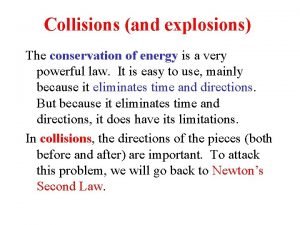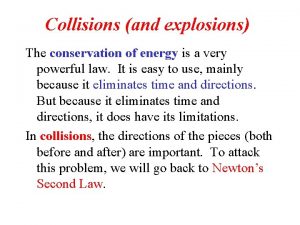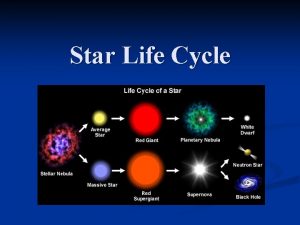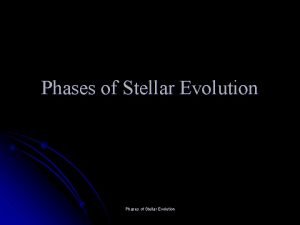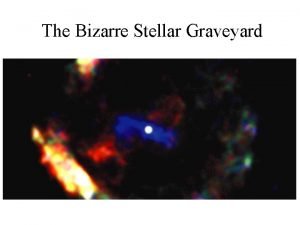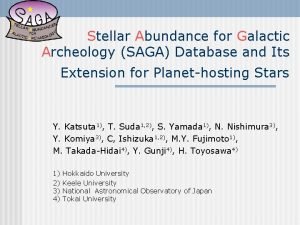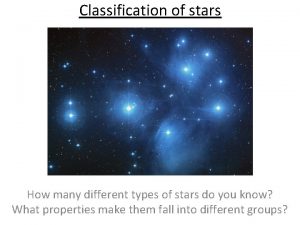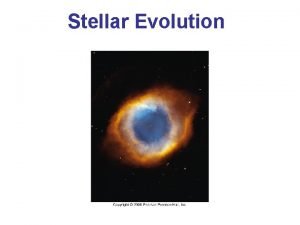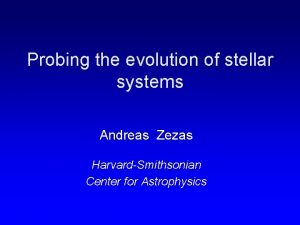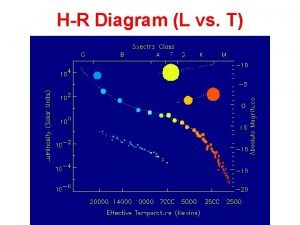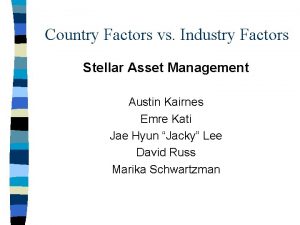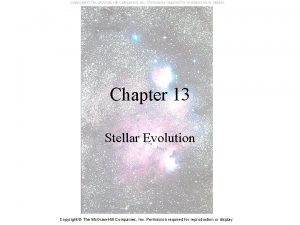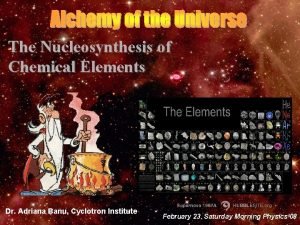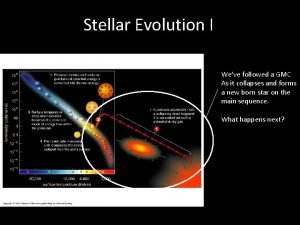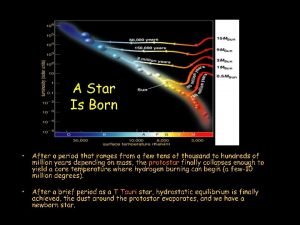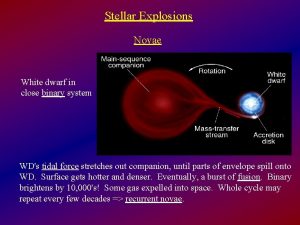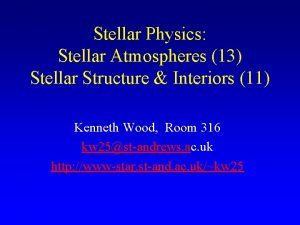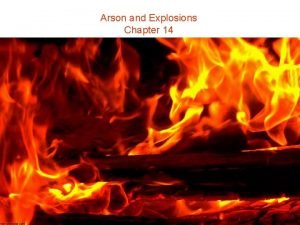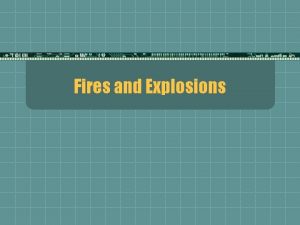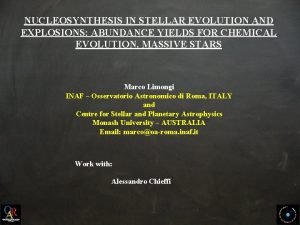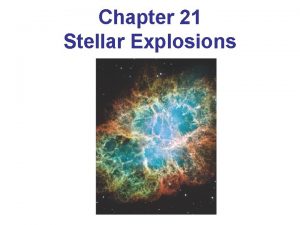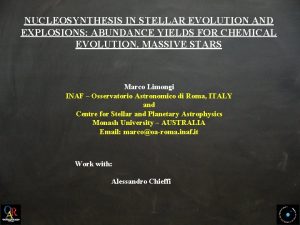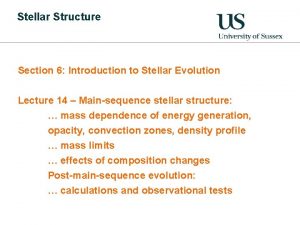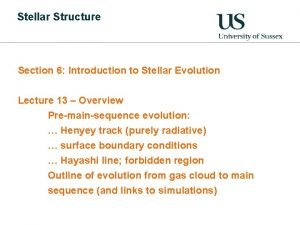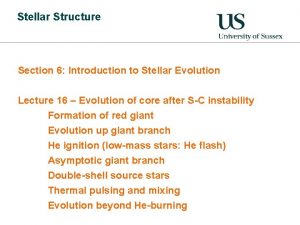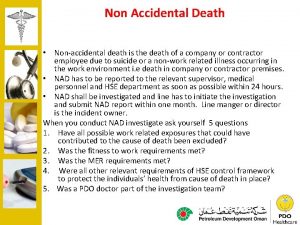Stellar Explosions Introduction Life after Death for White


























- Slides: 26

Stellar Explosions

Introduction Life after Death for White Dwarfs The End of a High-Mass Star Supernovae Supernova 1987 A The Crab Nebula in Motion The Formation of the Elements The Cycle of Stellar Evolution

Life after Death for White Dwarfs A nova is a star that flares up very suddenly and then returns slowly to its former luminosity:

Life after Death for White Dwarfs A white dwarf that is part of a semidetached binary system can undergo repeated novas:

Life after Death for White Dwarfs Material falls onto the white dwarf from its mainsequence companion. When enough material has accreted, fusion can reignite very suddenly, burning off the new material. Material keeps being transferred to the white dwarf, and the process repeats, as illustrated here:

The End of a High-Mass Star A high-mass star can continue to fuse elements in its core right up to iron (after which the fusion reaction is energetically unfavored). As heavier elements are fused, the reactions go faster and the stage is over more quickly. A 20 -solar-mass star will burn carbon for about 10, 000 years, but its iron core lasts less than a day.

The End of a High-Mass Star This graph shows the relative stability of nuclei. On the left, nuclei gain energy through fusion; on the right they gain it through fission. Iron is the crossing point; when the core has fused to iron, no more fusion can take place.

The End of a High-Mass Star The inward pressure is enormous, due to the high mass of the star. There is nothing stopping the star from collapsing further; it does so very rapidly, in a giant implosion. As it continues to become more and more dense, the protons and electrons react with one another to become neutrons:

The End of a High-Mass Star The neutrinos escape; the neutrons are compressed together until the whole star has the density of an atomic nucleus, about 1015 kg/m 3. The collapse is still going on; it compresses the neutrons further until they recoil in an enormous explosion as a supernova.

Supernovae A supernova is incredibly luminous, as can be seen from these curves – more than a million times as bright as a nova.

Supernovae A supernova is a one-time event – once it happens, there is little or nothing left of the progenitor star. There are two different types of supernovae, both equally common: Type I, which is a carbon-detonation supernova; Type II, which is the death of a high-mass star just described.

Supernovae Carbon-detonation supernova: white dwarf that has accumulated too much mass from binary companion If the white dwarf’s mass exceeds 1. 4 solar masses, electron degeneracy can no longer keep the core from collapsing. Carbon fusion begins throughout the star almost simultaneously, resulting in a carbon explosion.

Supernovae This graphic illustrates the two different types of supernovae:

Supernovae are rare; there has not been one in our Galaxy for about 400 years. A supernova, called SN 1987 A, did occur in the Large Magellanic Cloud, a neighboring galaxy, in 1987. Its light curve is somewhat atypical:

Supernovae A cloud of glowing gas is now visible around SN 1987 A, and a small central object is becoming discernible:

Supernovae leave remnants – the expanding clouds of material from the explosion. The Crab nebula is a remnant from a supernova explosion that occurred in the year 1054.

Supernovae The velocities of the material in the Crab nebula can be extrapolated back, using Doppler shifts, to the original explosion. There does seem to be a neutron star at the center of the Crab nebula:

The Formation of the Elements There are 81 stable and 10 radioactive elements that exist on our planet. Where did they come from? This graph shows the relative abundances of different elements in the universe:

The Formation of the Elements Some of these elements are formed during normal stellar fusion. Here, 3 helium nuclei fuse to form carbon:

The Formation of the Elements Carbon can then fuse, either with itself or with alpha particles, to form more nuclei:

The Formation of the Elements The elements that can be formed through successive alpha-particle fusion are more abundant than those created by other fusion reactions:

The Formation of the Elements The last nucleus in the alpha-particle chain is nickel-56, which is unstable and quickly decays to cobalt-56 and then to iron-56. Iron-56 is the most stable nucleus, so it neither fuses nor decays. However, within the cores of the most massive stars, neutron capture can create heavier elements, all the way up to bismuth-209. The heaviest elements are made during the first few seconds of a supernova explosion.

The Formation of the Elements This theory of formation of new elements in supernova explosions produces a light curve that agrees quite well with observed curves:

The Cycle of Stellar Evolution Star formation is cyclical: stars form, evolve, and die. In dying, they send heavy elements into the interstellar medium. These elements then become parts of new stars. And so it goes.

Summary • A nova is a star that suddenly brightens and gradually fades; it is a white dwarf whose larger partner continually transfers material to it. • Stars greater than 8 solar masses can have fusion in their cores going all the way up to iron, which is stable against further fusion. • The star continues to collapse after the iron core is found, implodes, and then explodes as a supernova.

Summary, cont. • Two types of supernovae: • Type I, a carbon-detonation supernova • Type II, a core-collapse supernova • All elements heavier than helium are formed in stars: • Elements up to bismuth-209 are formed in stellar cores during fusion • Heavier elements are created during supernova explosions
 Collisions and explosions
Collisions and explosions Collisions
Collisions After me after me after me
After me after me after me John 14
John 14 Flowchart of the life cycle of a star
Flowchart of the life cycle of a star What do muslims believe about life after death
What do muslims believe about life after death Define forensic pathology
Define forensic pathology Atmospheric heaven
Atmospheric heaven Mizar luminosity
Mizar luminosity Stellar evolution diagram
Stellar evolution diagram Stellar evolution diagram
Stellar evolution diagram Stellar motion matlab
Stellar motion matlab Virgo stellar
Virgo stellar Stellar graveyard
Stellar graveyard Stellar hosting iptv
Stellar hosting iptv Stellar assessment
Stellar assessment Stellar saga
Stellar saga What is stellar parallax?
What is stellar parallax? Stellar evolution
Stellar evolution Stellar
Stellar Stellar formation
Stellar formation Stellar asset management
Stellar asset management Stellar evolution
Stellar evolution Adriana banu
Adriana banu Stellar evolution
Stellar evolution Stellar evolution diagram
Stellar evolution diagram Stellar wifi
Stellar wifi
